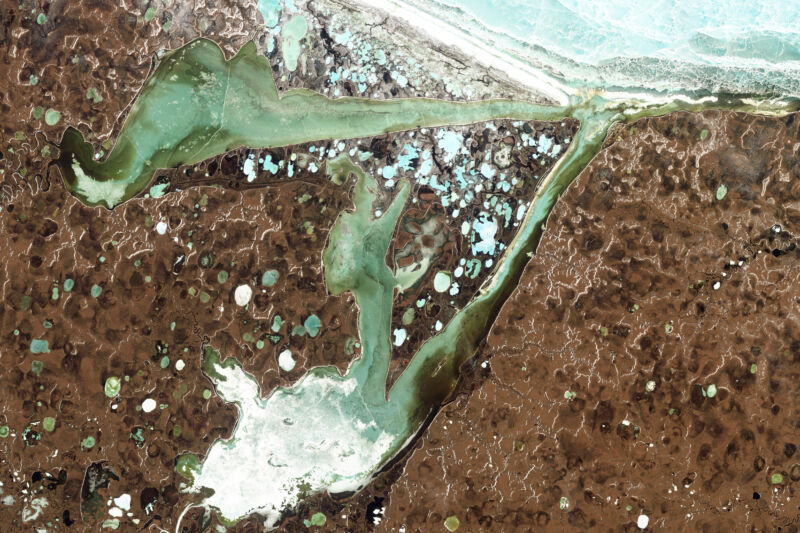
Arctic permafrost has long had a sort of “here there be dragons” status when it comes to climate change. The thawing of permafrost represents a positive feedback that amplifies warming by releasing more greenhouse gas into the atmosphere. But characterizing plausible future scenarios in which that release takes place hasn’t been easy.
Making careful measurements of local permafrost thawing has enabled scientists to simulate the general behavior and incorporate that into models. So far, however, those models have been limited to the gradual change that occurs as warming temperatures allow the thawing to reach slightly greater depths each successive summer. But a new study led by Merritt Turetsky at the University of Colorado, Boulder, simulates something different, based on a recent data-gathering effort: abrupt-thaw processes.
Sudden change
Abrupt thaw can occur in a few different ways but generally relates to pockets of permafrost with a larger percentage of ice inside. If that ice melts, the soil will deflate and collapse. On hillsides, soil may slump downslope or create a new drainage gully. And in low-lying areas, it can create a new wetland or lake as water fills the depression. Both situations can accelerate thaw and carbon-release processes greatly.
A global model obviously can’t include every hillock and pond, but it can try to incorporate average behavior over a larger area. That’s what the research team did, adding abrupt thaw to climate model simulations of two scenarios of human emissions from 2000 to 2300. (Permafrost thaw is a long-term process, so stopping at 2100 doesn’t make sense.)
In the high-emissions scenario, the fast release processes released 80 ±19 billion tons of carbon by 2300. Similar simulations of gradual thaw produced around 200 billion tons. So although abrupt thaw only occurs over about 5 percent of the permafrost area in the model, it releases about 40 percent as much carbon as the gradual thaw everywhere else. A larger share of the carbon from abrupt thawing is released as methane—a more potent greenhouse gas—so the warming impacts of the two categories were roughly equivalent through the year 2100.
A gradual transition
Later in the simulations, an interesting transition takes place in the abrupt thaw lakes and wetlands. These bodies of water evolve from sources of greenhouse gas to carbon-absorbers. This is partly due to a natural ecosystem progression and partly due to the fact that they tend to drain and dry out as the region warms further. The presence of oxygen means carbon comes out as CO2 rather than methane, and vegetation also gets re-established, taking in CO2. Without this process, abrupt thaw would release a lot more carbon in the simulations.
The lower human-emissions scenario represents a moderate reduction below our current (promised) path, limiting global warming to less than 3°C. In this simulation, abrupt-thaw processes release about half as much carbon. Simulations of gradual thaw have shown that it’s possible this level of warming would produce more carbon uptake by Arctic plant growth than is released from the permafrost. However, adding in abrupt thaw would tip the scale to a positive number. Still, it’s a much smaller greenhouse gas contribution than we’d see in a high-emissions scenario.
So how does that contribution compare to human-caused emissions? Our current emissions come in at around 11.5 billion tons of carbon per year. Between gradual and abrupt-thaw emissions, the high scenario would be adding the equivalent of over 1 billion tons per year by 2100. If we followed the lower human-emissions scenario, that would drop considerably.
This study represents a first pass at these numbers, even if it’s a very involved first pass. The results indicate that the carbon released by abruptly thawing permafrost is far from trivial but also unlikely to be a monster that dwarfs the gradual processes already being simulated.
Nature Geoscience, 2020. DOI: 10.1038/s41561-019-0526-0 (About DOIs).
"much" - Google News
February 07, 2020 at 05:07AM
https://ift.tt/2OxkHDJ
New estimate of how much thawing permafrost will worsen warming - Ars Technica
"much" - Google News
https://ift.tt/37eLLij
Shoes Man Tutorial
Pos News Update
Meme Update
Korean Entertainment News
Japan News Update
Bagikan Berita Ini















0 Response to "New estimate of how much thawing permafrost will worsen warming - Ars Technica"
Post a Comment